
Caption: This adult ground beetle is 3/4 inch long. Note the mandibles: definitely a predaceous beetle.
Photo by: J. Vander Houwen, WSU Extension
|
|
Predaceous ground beetles (Carabids)
(revision date: 1/11/2019)
Use Integrated Pest Management (IPM) for successful pest management.
Biology
The predaceous ground beetles, or carabids, belong to one of the largest beetle families in North America. There is considerable variation in color, size, and shape between the many species. Most of the carabids are black to brightly iridescent or metallic, shiny, and broadly oval in outline with prominent mouthparts. The elytra (the hardened wing covers) are often marked with grooved lines or with rows of punctate dots. Size varies widely between species, with common northwest species ranging from approximately 1/4 inch to over an inch in length. Adult beetles are nocturnal hunters, hiding in the daytime beneath plant debris, rocks, logs, or leaves, often in gardens or flower beds. They typically run rapidly when disturbed, seldom flying in the daytime. The larvae are usually found in soil, under bark, or in plant debris at ground level. Both adults and larvae are predaceous. Some species are known to feed on snails, while others feed on caterpillars, insect eggs, and insects. Ground beetles can be attracted to lights at night and may enter homes and become a nuisance. Some species release chemicals which can irritate sensitive skin, while others emit an unpleasant odor. Ground beetles, particularly the larger species, may be capable of biting and should not be handled bare-handed. Both adults and larvae of predaceous ground beetles are considered beneficial. See WSU Publication 'Beneficial Insects, Spiders, and Other Mini-Creatures in Your Garden (EM067E)' by Dr. David James at http://pubs.wsu.edu for more information about beneficial insects.
|
